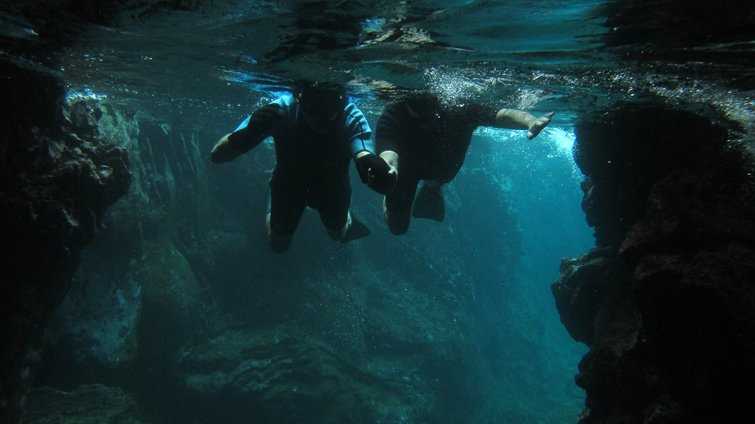The early start to the day did not deter many – so out the door we left at 6:30 am sharp. The soft brown inorganic beach with tiny green peridots was the setting for some unexpected, but hoped for, blue-footed boobies! These sea birds are tremendously notorious for their fickle choice of nesting sites. The last decade has seen them move about the various islands of the archipelago, but breeding hasn’t been constant in any one location.
But here they were! On top of a low bluff of cinder, the remnants of an explosion millennia ago. Then inland a glimpse of Galapagos flamingos in a brackish-saline lagoon, accompanied by a few white-cheeked pintail ducks who left v-shaped trails behind them as they crossed the still waters.
Over the hill, the descent leads to the opposite kind of sand deposit – an organic beach made of finely crushed calcium carbonate material (made probably by passing through the gut of various marine fish). Soon, very soon, this beach will have tracks made by nocturnal visits from the east Pacific green sea turtles. The warm, wet season is almost upon us and so they lay their eggs in the knowledge that the next 3-4 months of warm temperatures will incubate their investment in the next generation.
After breakfast the ship repositioned to Champion Islet. An important island for the conservation of Galapagos species, it is one of two remaining islands that still supports populations of Floreana mockingbirds. These land birds no longer inhabit the main island of Floreana for various reasons- introduced black rats, introduced parasitic flies, feral cats, lack of prickly pear cactus habitat in the lowlands. No one is absolutely sure of the reason, but any of these situations could be what prohibits the successful re-colonization of the main island with Floreana mockingbirds. However, the “Floreana Project” is working on these challenges as well as many others to restore the island. We will see!
Snorkeling, as always for me, was the very best! A white-tipped reef shark was seen by some, blue-chin parrotfish and Galapagos sea lions by all! Could it get any better? Wet but happy, we were back by lunchtime and mid-afternoon (after siesta) Salvador gave a presentation on the oceanographic and geologic setting of the Galapagos. It is of tremendous help to have this explained clearly – everything about, around, and on the islands relates to the ocean and the geology of these remarkable, young islands.
In the afternoon it was an easy visit to the famous Post Office Barrel. Just behind the first line of bushes off the beach, there was placed a barrel by an unknown ship’s captain back in the late 1790’s. Captain James Colnett was the first to mark it on his chart of the islands, and since then it has been used regularly by ships passing through. Today the tradition lives on: if we find postcards left that are addressed close to our homes (or on our radar for visiting soon), we take them with the promise to hand-deliver. In turn, postcards are left hoping that future passing visitors will deliver by hand and surprise the addressee one day!
Zodiac rides took us for an exploration of the quiet waters off-shore where sea lions and green sea turtles live, sleep, eat and rest. Several kayakers chose to visit these quiet waters as well, but sat closer to the water – a different perspective and which certainly burned more energy!
By sunset we were returning to the National Geographic Islander, just in time for a bit of wine-tasting on the top deck. As the alpenglow intensified, so daily does our understanding of the importance, the fragility, and the uniqueness of this island archipelago in the remote eastern Pacific Ocean.









